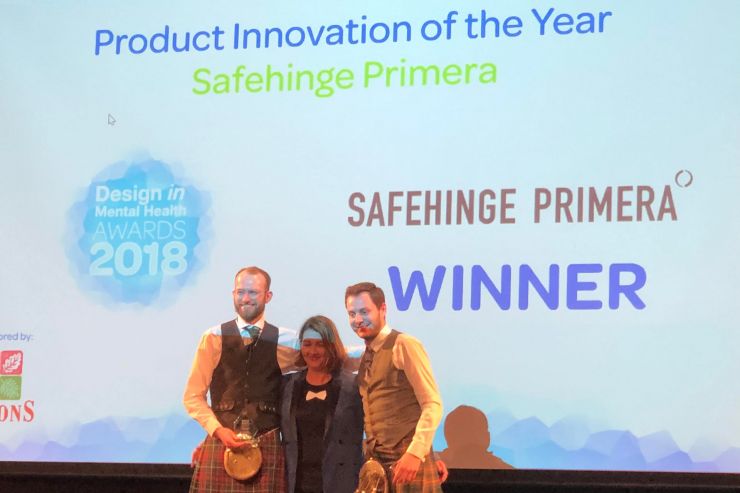In a mental health ward or secure SEN classroom, the smallest detail can hold the greatest responsibility.
For a clinician reaching someone in distress, or a teacher calming a pupil in crisis, a door isn’t just part of the building — it’s part of the safety system that protects everyone inside.
A reliable lockset doesn’t simply secure a room; it protects lives, preserves trust, and helps people feel safe enough to recover, learn, or care for others.
Yet every day, estates teams and specifiers face a complex equation: how to balance security, safety, and accessibility.
In environments where seconds matter, that choice can be the difference between calm intervention and crisis escalation.
So the question becomes:
How do you create security without fear, safety without restriction, and control without compromise?
Designing with Both Sides of the Door in Mind
At Safehinge Primera, we design for both sides of the door — the staff who need to act quickly, and the people whose privacy and dignity must be protected.
Our High Secure Lockset was built from the ground up for the most demanding conditions: mental health wards, secure SEN schools, and high-risk healthcare environments.
It’s frame-mounted for strength, tested to FD30 and FD60 standards, and fully aligned with NHS and DfE guidance.
Every feature is designed to perform under pressure, but without dominating the space visually. It fits quietly and seamlessly into therapeutic and educational environments, reinforcing calm rather than control.
The result is a lockset that delivers safer working for staff, and a greater sense of trust and security for the people they support.
“When safety systems just work, people can focus on what really matters — care, learning, and recovery.”
Fail Safe or Fail Secure: A Crucial Choice
For many specifiers and estates teams, the question of fail safe versus fail secure operation is where technical decisions meet human realities.
Fail Safe – Unlocks on Power Loss
When power is lost, a fail safe lock automatically unlocks. This mode is essential in spaces where safe evacuation is the priority — such as fire escape routes, hospital corridors, or SEN classrooms.
It ensures that in an emergency or power outage, people can always exit quickly and safely without barriers.
Fail Secure – Stays Locked on Power Loss
In contrast, a fail secure lock remains locked if power fails. It’s the right choice for high-risk or controlled areas like mental health wards, medication stores, or secure entrances, where preventing unauthorised access is critical.
Here, security must be maintained even during disruption.
Understanding when and where to specify each mode isn’t just a matter of compliance — it’s about ensuring that doors behave predictably when people are under pressure.
The right configuration gives staff the confidence to act fast and decisively, knowing that safety is built in, not bolted on.
Built for Strength, Engineered for Simplicity
Traditional locksets often require complex door leaf alterations — drilling, routing, or wiring that can weaken structure, add failure points, and complicate maintenance.
The Safehinge Primera frame-mounted system changes that. It relocates the mechanism from the leaf into the frame, protecting the door’s structural integrity while simplifying installation.
- Robustness: Tapered locking pins resist lateral forces up to 40,000N, ensuring reliable performance in high-abuse environments.
- Simplicity: No door leaf wiring means faster fitting and easier replacement, reducing downtime and disruption to active wards or classrooms.
- Flexibility: Suitable for single, double, and corridor doors, with options for side or head mounting to suit varying layouts.
- Ease of maintenance: Frame access allows for quick inspection and part replacement without disturbing the door set — a key advantage for operational continuity.
In short, it’s a lockset that takes pressure off people, not just doorframes.
Designed for Compliance, Proven in Practice
In healthcare and education, compliance isn’t optional — it’s a matter of duty, safety, and reputation.
Every component in the High Secure Lockset has been designed to meet and exceed the relevant standards:
- Fire Performance: Tested and certified to FD30 and FD60 in accordance with BS 476-22:1987.
- Regulatory Alignment: Designed in line with HTM 08-03 (NHS) for doorsets in healthcare settings and DfE Building Bulletin 100 for education environments.
- Security: Meets PAS 24 impact and tamper resistance requirements.
- Accessibility: Compatible with BS 8300 for inclusive design.
By choosing a product pre-tested to these standards, estates teams can demonstrate due diligence, reduce approval times, and ensure regulatory confidence.
For Architectural Ironmongers and specification partners, that level of compliance means fewer grey areas and a smoother path from design to delivery.
Why Frame-Mounted Locksets Simplify Specification
From a specifier’s standpoint, standardisation is everything. Fragmented systems and bespoke retrofits can create long-term headaches — maintenance inconsistency, unclear fire certification, and unpredictable lead times.
The High Secure Lockset provides a standardised, productised solution that can be confidently rolled out across multiple projects.
For AIDMs, this means:
- A fully tested and certified system, reducing risk during specification and installation.
- Clear alignment with NHS and DfE requirements, ensuring smooth acceptance from estates and compliance teams.
- Compatibility with a range of electronic access control systems, including integrations with popular platforms such as Paxton.
- Documented lifecycle data to support long-term maintenance planning and ROI calculations.
For decision-makers and project managers, standardisation also means peace of mind — knowing every door behaves consistently, wherever it’s installed.
The ROI of Reliability
Every estates manager knows the hidden costs of unreliable hardware: cancelled beds, reactive maintenance, staff frustration, and reputational risk.
A durable, standardised lockset doesn’t just prevent incidents; it saves time, money, and stress across the building’s lifetime.
Consider the operational savings:
- Reduced maintenance labour due to easy frame access.
- Less downtime during replacement cycles.
- Extended service life thanks to heavy-duty engineering.
- Simplified staff training on a single, standardised system.
Beyond the numbers, the return on investment is cultural as much as financial. When people trust that their safety systems will work, it reduces anxiety, strengthens confidence, and helps staff focus on care, not contingency.
Human Impact: Safety That Feels Invisible
Hardware should never make people feel confined. In mental health settings especially, the physical environment must protect without punishing, offering security that feels almost invisible.
That’s why every Safehinge Primera design decision begins with empathy. We work alongside clinicians, estates teams, and service users to understand what “safe” really means in practice.
The High Secure Lockset embodies that philosophy: engineered strength, delivered with human sensitivity.
- For staff, it means knowing they can reach someone in distress, fast and safely.
- For AIDMs, it means confidence that every component stands up to scrutiny.
- For patients and pupils, it means safety that protects their dignity and freedom.
Because the right lockset doesn’t just secure a space — it builds trust on both sides of the door.
A Stronger Standard for Safer Futures
Safety and dignity shouldn’t be competing priorities. The High Secure Lockset proves they can be one and the same — robust enough to withstand force, refined enough to blend into therapeutic design.
In a world where compliance can feel like a tick-box exercise, it offers something better: reassurance that design, engineering, and empathy can coexist.
When hardware performs quietly, people can focus on what really matters. Care. Learning. Recovery.
That’s the standard we build for — and it’s what every secure space deserves.
Want to learn more?
Explore our full High Secure Lockset technical specification, or speak to our team about project integration, lifecycle costing, or compliance documentation.
Together, we design for good — and for safer living.



